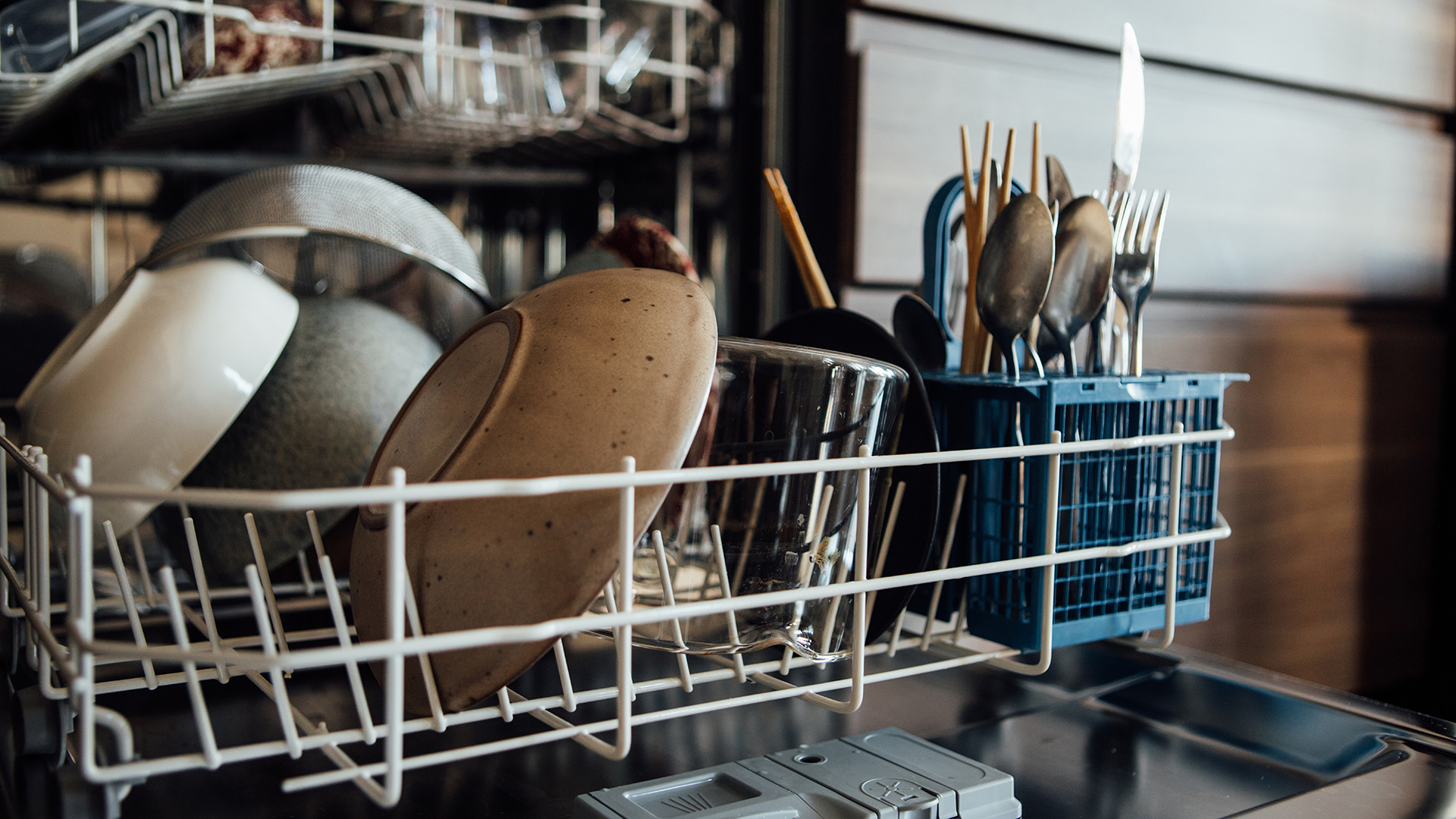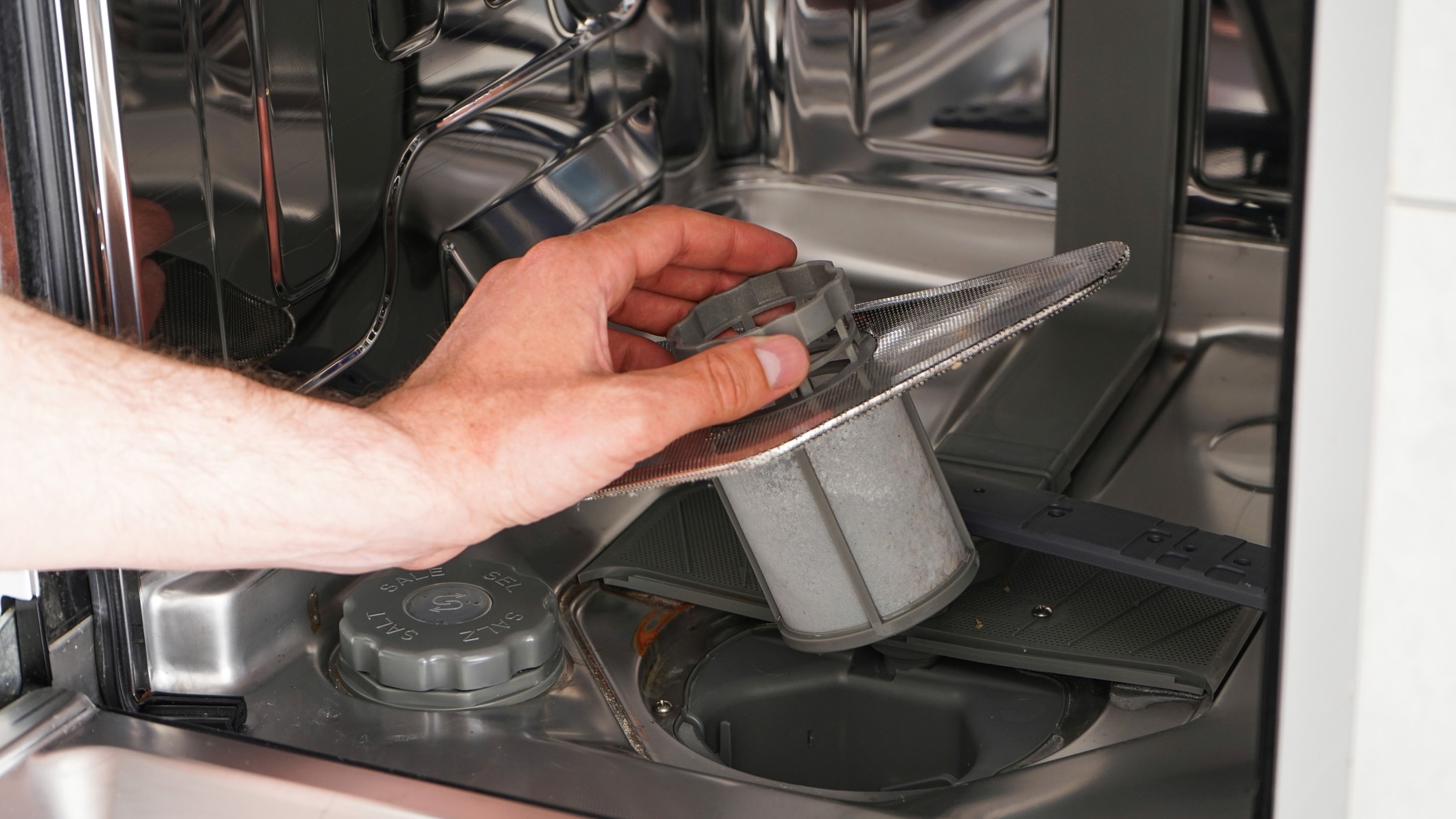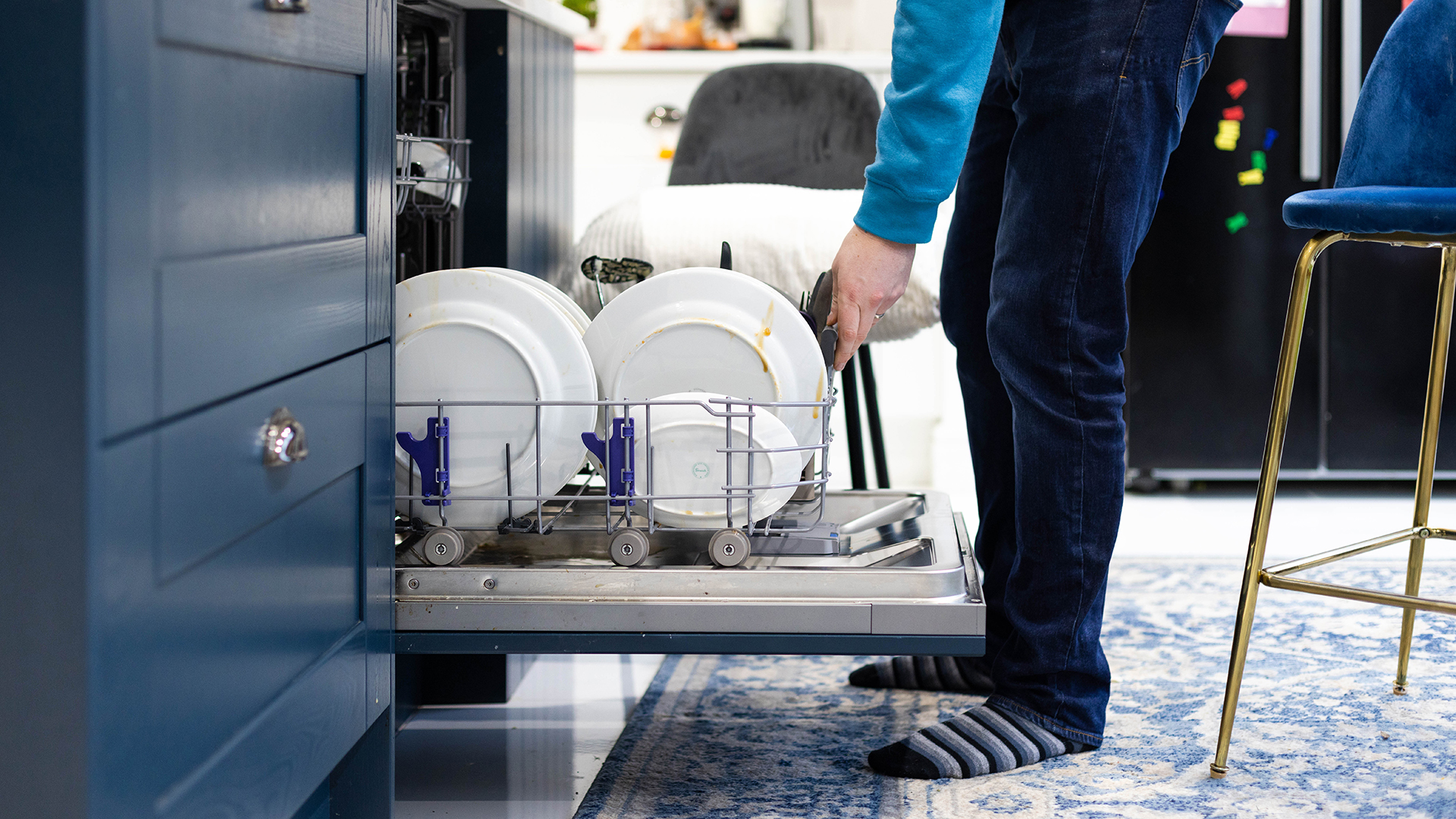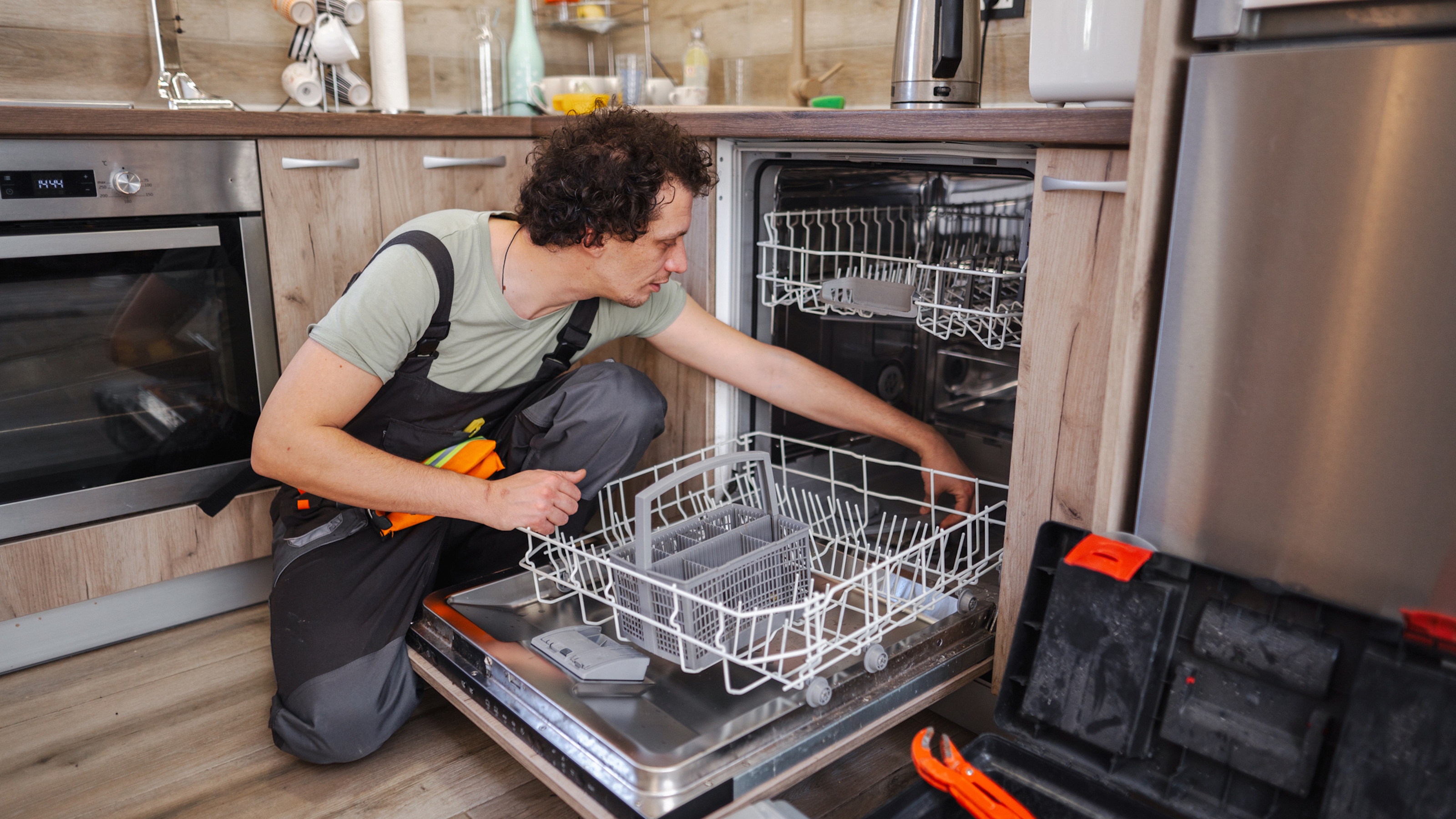Have you opened your dishwasher to find a standing pool of water and dirty plates? If so, you have a clog. Luckily, you don’t need to be a repair expert to fix the issue.
- Rubber gloves
- Old towels or rags
- Bowl or a cup
- Binbag
- Flexible pipe cleaner
- White vinegar
- Toothpicks
- Toothbrush
- Handheld steamer (optional)
- Wet vac (optional)
Clogs can happen for various reasons: Bits of food and grease build up over time, the drain hose might be blocked, or the spray arms might be clogged. This step-by-step guide covers everything you need to know, from checking the garbage disposal to cleaning spray arms and using a handheld steamer for stubborn grease.
I’ve also got plenty of expert advice on dishwasher maintenance, from spotting the warning signs of a clog to simple tips to make blockages less likely. Armed with this guide and a little patience, your dishwasher will run smoothly in no time.
How to unclog a dishwasher: quick steps
- Empty dishwasher, then turn it off and unplug it
- Soak up standing water
- Clean the filter
- Inspect the drain hose
- Tackle the spray arms
- Run a trial cycle

How to unclog a dishwasher: step-by-step guide
1. Empty dishwasher, then turn it off and unplug it
Before you start, empty your dishwasher of dishes and cutlery, then turn off it and unplug it from the power source. Water and electricity don’t mix, so this is a non-negotiable step. You'll also need to pull out or remove the lower basket to reach the filter more quickly.
2. Soak up standing water
If standing water is in the bottom of the dishwasher, scoop out as much as you can with a bowl or a cup. Then, soak up any remaining water with old towels or rags before proceeding. This will make accessing components like the filter and drain hose easier without making a mess. Remember to wear rubber gloves to keep things hygienic. If you have a wet vac, use it to suction off any standing water.
3. Clean the filter

Locate your dishwasher’s filter - typically at the bottom of the machine. Depending on your dishwasher brand, you may need a screwdriver to remove it, but most filters these days can be released with a quarter turn clockwise. Refer to your user manual if you're not sure.
Appliance repair expert at Domestic & General, Ian Palmer-Smith, suggests "removing the filter and emptying any trapped food before scrubbing with a toothbrush. Finally, give it a quick rinse to remove every last bit of dirt and grime before reinserting and securing."

Ian Palmer-Smith is a Supplier and Heating Service Director at Domestic & General and a domestic appliance service and repair expert with over 35 years of professional experience.
4. Inspect the drain hose

Once you’ve located the drain hose, disconnect it carefully from the dishwasher. You might need pliers to loosen or remove the clamp for this part. It's a good idea to pop a pan or dish below the hose to catch any water that may spill.
Use a flexible pipe cleaner to clear out any blockages. If you don’t have a pipe cleaner to hand, an old wire coat hanger straightened out can work as a substitute. Wear rubber gloves and have old towels and a bin bag ready for any mess that might come out.
5. Tackle the spray arms

Often overlooked, according to Danny Pen, President of New Era Plumbing & HVAC, the spray arms at the top of the dishwasher can also be prey to clogs. If they are gunked up, your dishwasher simply won’t clean effectively.
Danny suggests wiping the spray arms with white vinegar to loosen and remove any blockages from the tiny holes and using a toothpick for precision cleaning. This step ensures water can flow freely during cycles. He also has a pro tip for tackling hard-to-remove build-up. "A handheld steamer can melt stubborn grease in seconds," says Danny. "It's your secret weapon for tackling clogs like a pro."

Danny Pen boasts over 12 years of experience in plumbing, heating, and cooling. He currently leads New Era Plumbing & HVAC, a local company specializing in inspection, repair, and replacement services. His company's mission is to deliver superior service to the communities they work within while providing the highest quality plumbing, HVAC, and drain services.
6. Run a trial cycle
Reconnect everything, restore power, and run a short cycle to see if the problem is resolved. If problems persist, it may be time to call in the professionals.

How to unclog a dishwasher: FAQs
What are the warning signs that a dishwasher is clogged?
If your dishwasher isn’t working, a few telltale signs could indicate a clog. President of Mr. Appliance, Glenn Lewis, explains, “The water will be draining slower and pooling at the bottom of the dishwasher after the cycle is complete. You might also see food residue on dishes.” Danny adds, "A foul odor or unusual gurgling sounds are also strong indicators of a blockage."
Danny suggests paying attention to how your dishes smell and the length of the washing cycle. “If dishes smell weird right after washing or if the cycle itself is too long, it might be a sign of a minor clog restricting water flow, which will become a bigger problem if ignored.” He also notes more signs, such as water pooling at the bottom, greasy or dirty dishes, and strange 'choking' sounds that could mean your dishwasher is struggling.

Glenn Lewis was named president of Mr. Appliance, North America’s leading appliance repair franchise providing customers with full-service residential and light commercial appliance repair, in May 2024. He is responsible for the overall leadership and growth of Mr. Appliance throughout the US and Canada.
Is there any way to prevent a dishwasher from clogging?
To keep your dishwasher running smoothly, staying on top of regular maintenance is essential. Check and clean the filter regularly to prevent food particles from building up and causing clogs. It’s also important to check the drain regularly to make sure the drain hose isn't kinked or blocked.
Scraping off food debris from dishes before loading them, particularly sticky or fatty foods like pasta, rice, or sauces, will help ensure better cleaning results. Danny adds that leaving some food particles on your dishes is okay, as modern dishwashers need them to clean effectively. But he advises against rinsing thoroughly.
Danny also recommends sprinkling baking soda inside your dishwasher before running a rinse cycle to help keep drains clear. You can try this maintenance tip once a week. And don't forget to clean the spray arms periodically to avoid any build-up in the tiny jets.
I spoke to Aminah Vieira, Head of Marketing and Innovation at InspireClean, who advises adding a little dishwasher TLC to your monthly routine. "Once a month, it’s a good idea to run a hot cycle with a cup of vinegar in a dishwasher-safe container on the top rack," says Aminah. "This method is gentle on your dishwasher's components but effective at preventing clogs and build-up."
Overloading your dishwasher can restrict the water flow and lead to poor cleaning, which may eventually cause clogs. So be mindful of your dishwasher's capacity and leave enough space for water and detergent to reach all surfaces.
Using the right detergent is also essential, so opt for high-quality products and avoid using too much, as excess soap can leave residues that can accumulate and cause clogs.
Finally, after each wash, leaving the door slightly ajar for a few hours allows the moisture to escape, helping to prevent mold and mildew growth, which can lead to clogs and unpleasant smells.
By following these simple tips and combining them with regular maintenance, you'll not only ensure clean tableware but also help keep your dishwasher running efficiently for years to come. "Worse than poor cleaning performance, a clogged dishwasher can lead to water damage, mold growth, and unpleasant smells that affect your whole kitchen," says Aminah. In severe cases, we've seen clogs cause motor burnout." These preventative steps will safeguard your appliance, protect your kitchen, and save you from costly repairs.

Aminah is head of Marketing and Innovation at InspireClean, a women-owned and locally operated house cleaning service in Southern Ontario, Canada. She brings a fresh perspective to the cleaning industry, constantly seeking innovative ways to enhance services and exceed customer expectations.
Final thoughts
Regular maintenance and care are key to preventing dishwasher clogs and ensuring efficient operation. By following the expert advice outlined in this guide, such as scraping away food, cleaning the filter, inspecting the spray arms, and running maintenance cycles with vinegar and baking soda, you can reduce the risk of blockages and prolong the life of your appliance.
Whether dealing with a minor blockage or aiming to prevent future clogs, our advice will ensure your machine stays clean, efficient, and ready to deliver sparkling results for years.

